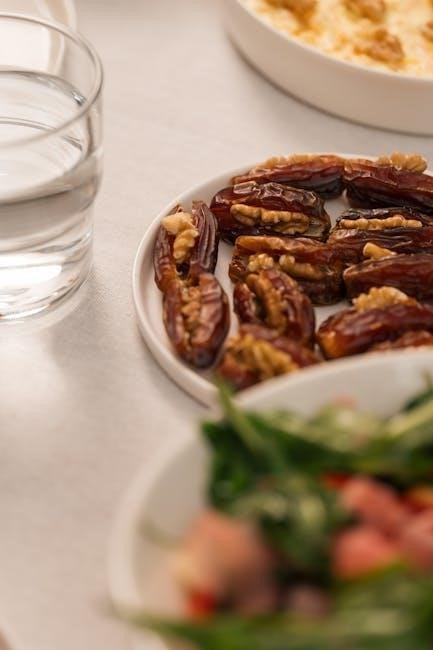7-Day Meal Plan for Ulcers
This meal plan provides balanced, nutrient-rich meals to support healing and comfort. Download the 7-Day Meal Plan for Ulcers PDF for detailed recipes and guidance. Avoid trigger foods like spicy, acidic, or caffeinated items. Opt for gentle options such as oatmeal, bananas, and lean proteins to soothe the stomach lining.
Welcome to the 7-Day Meal Plan for Ulcers, designed to help you manage symptoms, promote healing, and maintain a balanced diet. This plan focuses on gentle, soothing foods that support digestive health while avoiding triggers like spicy, acidic, or caffeinated items. Each day includes nutrient-rich meals to provide energy and comfort.
Oatmeal, bananas, lean proteins, and whole grains are key components, as they are easy on the stomach and aid in reducing irritation. The plan emphasizes anti-inflammatory foods and avoids those that stimulate gastric acid production. By following this structured approach, you can alleviate discomfort and support your body’s natural healing processes.
Remember, everyone’s digestive system is unique, so it’s important to tailor this plan to your specific needs. Always consult with a healthcare provider or dietitian for personalized advice. This meal plan is a starting point to help you feel better and regain control over your digestive health. Let’s get started on your journey to wellness!
Day 1

Start your week with gentle, soothing meals designed to ease stomach discomfort and support healing. Breakfast, lunch, and dinner are carefully chosen to be low in acid and easy to digest.
- Breakfast: Scrambled eggs with a slice of whole-grain toast and a small side of steamed spinach.
Scrambled eggs are a great source of protein and are gentle on the stomach lining. Pairing them with whole-grain toast provides fiber, while steamed spinach adds essential vitamins without causing irritation. - Lunch: Grilled turkey breast with quinoa and steamed zucchini.
Grilled turkey breast is lean and easy to digest. Quinoa offers a good source of complex carbohydrates and protein, while steamed zucchini is soft and soothing for the digestive system. - Dinner: Baked cod with roasted sweet potatoes and a small cucumber salad dressed in olive oil.
Baked cod is a low-acid protein that supports healing. Sweet potatoes are rich in vitamins and fiber, and cucumbers are mild and hydrating, making this meal both nourishing and gentle on the stomach.
Feel free to adjust portion sizes based on your needs and tolerance. Staying hydrated with water or herbal teas throughout the day is also recommended.
Day 2
Continue your healing journey with Day 2 of the meal plan, focusing on nutrient-dense, easy-to-digest meals that promote stomach comfort and reduce irritation.
- Breakfast: Greek yogurt (non-fat) topped with a drizzle of honey and sliced peaches.
Greek yogurt is a soothing, probiotic-rich option that supports gut health. Honey adds a touch of sweetness without irritating the stomach, while peaches provide essential vitamins and fiber. - Lunch: Chicken and vegetable stir-fry with brown rice.
This meal combines lean protein with soft, easily digestible vegetables like carrots, zucchini, and bell peppers. Brown rice adds complex carbohydrates for sustained energy without causing discomfort. - Dinner: Roasted chicken breast with mashed potatoes and steamed green beans.
Roasted chicken breast is a low-acid protein source that’s gentle on the stomach. Mashed potatoes are soft and easy to digest, while green beans provide a light, non-irritating vegetable option.
Drink water or herbal teas throughout the day to stay hydrated and support digestion. Avoid adding any spices or seasonings that might trigger discomfort.

Day 3
On Day 3, focus on meals that are easy to digest while providing essential nutrients for healing. Avoid spicy or acidic foods that could irritate the stomach lining.
- Breakfast: Scrambled eggs with a slice of whole-grain toast and a small side of steamed spinach.
Scrambled eggs are a gentle protein source, while whole-grain toast provides fiber without causing irritation. Steamed spinach is soft and rich in vitamins and antioxidants. - Lunch: Berry smoothie with almond milk, chia seeds, and a drizzle of honey.
This smoothie is soothing and packed with anti-inflammatory properties. Berries are easy to digest and provide antioxidants, while chia seeds add omega-3 fatty acids for gut health. - Dinner: Baked salmon with roasted carrots and quinoa.
Baked salmon is a lean protein that’s gentle on the stomach. Carrots are soft and easy to digest, while quinoa offers complex carbohydrates and fiber for sustained energy.
Stay hydrated by drinking water or herbal teas throughout the day. Avoid adding heavy seasonings or spices to your meals, as they may trigger discomfort. This meal plan is designed to promote healing and reduce ulcer symptoms while providing balanced nutrition.
Day 4
Day 4 focuses on incorporating lean proteins, whole grains, and non-acidic vegetables to support healing and digestion. These meals are designed to be gentle on the stomach while providing essential nutrients.
- Breakfast: Greek yogurt (non-fat) topped with honey and fresh berries.
Greek yogurt is soothing and non-acidic, making it ideal for ulcers. Honey adds natural sweetness without irritation, while berries provide antioxidants and fiber. - Lunch: Grilled chicken breast with brown rice and steamed green beans;
Grilled chicken is a lean protein that’s easy to digest. Brown rice offers complex carbohydrates, and green beans are soft and non-irritating. - Dinner: Roasted turkey breast with mashed sweet potatoes and a small cucumber salad.
Turkey breast is another lean protein option. Sweet potatoes are rich in vitamins and fiber, while cucumbers add hydration and mild flavor. - Snack: Rice cakes with almond butter and a herbal tea.
Rice cakes are easy to digest, and almond butter provides healthy fats without triggering discomfort. Herbal tea, like chamomile or peppermint, can help soothe the stomach.
These meals are carefully chosen to avoid triggering symptoms while ensuring you receive the nutrients needed for healing. Stay consistent with this plan and avoid adding heavy spices or acidic ingredients.
Day 5

Day 5 emphasizes nutrient-dense, anti-inflammatory foods to support healing while keeping the stomach lining protected. These meals are designed to be flavorful yet gentle, avoiding acidic or spicy ingredients.
- Breakfast: Scrambled eggs with steamed spinach and a slice of whole-grain toast.
Eggs are a great source of protein and easy to digest. Spinach adds essential vitamins and minerals without causing irritation. Whole-grain toast provides sustained energy. - Lunch: Baked cod with quinoa and steamed carrots.
Cod is a lean, mild fish that’s gentle on the stomach. Quinoa offers a complete protein and fiber, while carrots are soft and easy to digest. - Dinner: Roasted chicken breast with mashed potatoes and green beans.
Chicken breast is a lean protein that’s easy to tolerate. Mashed potatoes are soothing and non-acidic, while green beans provide essential vitamins and fiber. - Snack: Sliced apples with a tablespoon of almond butter.
Apples are gentle on the stomach and high in fiber, while almond butter offers healthy fats without triggering discomfort.
These meals are thoughtfully prepared to avoid triggering symptoms while ensuring you receive the nutrients needed for recovery. Stick to non-spicy seasonings and avoid acidic foods to maintain comfort throughout the day.
Day 6
Day 6 focuses on incorporating anti-inflammatory and easily digestible foods to support the healing process. These meals are designed to be gentle on the stomach while providing essential nutrients for recovery.

- Breakfast: Greek yogurt with mixed berries and a drizzle of honey.
Greek yogurt is soothing and high in probiotics, which support gut health. Mixed berries add antioxidants without causing irritation, and honey provides a touch of sweetness. - Lunch: Vegetable soup with lean ground turkey and a side of steamed zucchini.
This soup is a comforting and nutrient-rich option. Lean ground turkey provides protein, while vegetables like carrots, celery, and potatoes are easy to digest. - Dinner: Roasted turkey breast with mashed cauliflower and green beans.
Turkey breast is a lean protein that’s gentle on the stomach. Mashed cauliflower is a low-acid alternative to potatoes, and green beans add essential vitamins and fiber. - Snack: A small apple with a tablespoon of sunflower seed butter.
Apples are gentle on the stomach and high in fiber, while sunflower seed butter offers healthy fats without triggering discomfort.
These meals are carefully chosen to minimize stomach irritation while ensuring you receive a balanced intake of nutrients. Avoid adding spicy or acidic seasonings, and opt for non-irritating herbs like basil or parsley for flavor. As always, consult with a healthcare provider or dietitian to tailor this plan to your specific needs.
Day 7
Day 7 emphasizes nutrient-dense, anti-inflammatory foods to support ongoing healing and digestive comfort. These meals are designed to be gentle on the stomach while providing essential vitamins and minerals.
- Breakfast: Scrambled eggs with spinach and a slice of whole-grain toast.
Scrambled eggs are a low-acid protein source, while spinach adds iron and antioxidants. Whole-grain toast provides fiber without causing irritation. - Lunch: Grilled chicken breast with quinoa and steamed asparagus.
Grilled chicken breast is a lean protein that’s easy to digest. Quinoa offers a complete amino acid profile and steady energy, while asparagus is a gentle, nutrient-rich vegetable. - Dinner: Baked salmon with roasted sweet potatoes and green beans.
Salmon is rich in omega-3 fatty acids, which reduce inflammation. Sweet potatoes are soothing and high in vitamin A, and green beans add essential vitamins and minerals. - Snack: A small pear with a tablespoon of almond butter.
Pears are hypoallergenic and easy to digest, while almond butter provides healthy fats and protein without triggering discomfort.
These meals are chosen for their ability to soothe the stomach lining, reduce inflammation, and provide sustained energy. Avoid adding spicy or acidic condiments, and opt for herbs like parsley or basil for flavor. Always consult a healthcare provider or dietitian to tailor this plan to your specific needs and ensure it aligns with your treatment goals.
Additional Tips
When following a 7-day meal plan for ulcers, there are several additional strategies to enhance healing and reduce discomfort. First, avoid trigger foods such as spicy, acidic, or high-fat items, as they can irritate the stomach lining. Instead, opt for bland, low-acid foods like bananas, oatmeal, and lean proteins, which are gentle on the digestive system.
- Stay hydrated: Drink plenty of water throughout the day to help flush out toxins and support digestion. Avoid carbonated beverages, caffeine, and alcohol, as they can exacerbate symptoms.
- Practice portion control: Eat smaller, more frequent meals to avoid overloading the stomach. This can help reduce acid production and prevent irritation.
- Incorporate anti-inflammatory foods: Foods rich in antioxidants, such as berries, leafy greens, and omega-3 fatty acids, can help reduce inflammation and promote healing.
- Be mindful of cooking methods: Choose steamed, baked, or grilled options instead of fried foods. Avoid heavy sauces or spices that may trigger discomfort.
- Manage stress: Stress can worsen ulcer symptoms. Practice relaxation techniques like deep breathing, meditation, or yoga to help manage stress levels.
- Read labels carefully: Avoid processed foods containing hidden acids or irritants. Opt for natural, whole foods whenever possible.
By combining these tips with the structured meal plan, you can create a comprehensive approach to managing ulcers and promoting long-term digestive health. Always consult a healthcare provider or dietitian to tailor your plan to your specific needs and ensure the best outcomes.
